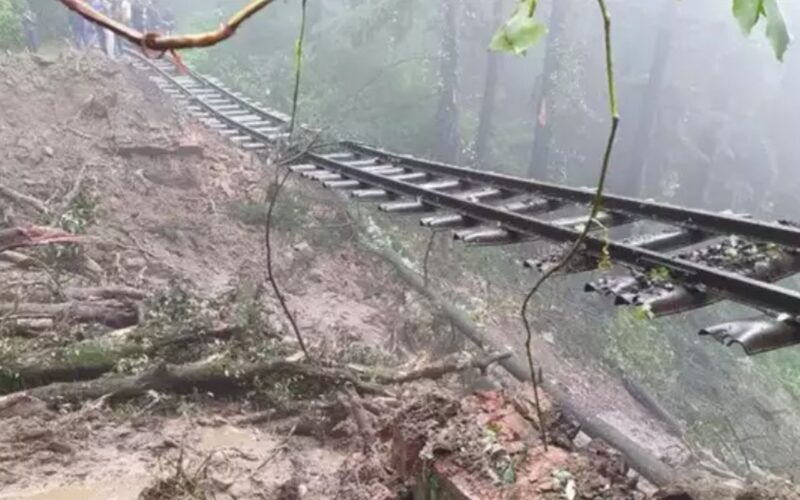<p>The recent tragic events of landslides and floods in the two northern Indian states of Himachal Pradesh and Uttarakhand serve as a crucial reminder that environmental concerns should not be compromised for the sake of development. It&#8217;s essential to recognize that development that fails to consider the capacity to withstand irregular weather conditions and changes in the environment is not true development; in fact, it can be a contributing factor to such disasters.</p>



<p>The continuous rainfall in the Himalayan region this week has led to the unfortunate loss of at least 72 lives and substantial landslides. The floods caused roads to be submerged and vehicles and buildings to be washed away. Many are injured, and several remain missing.</p>



<p>Himachal Pradesh, the most affected area, is currently engaged in relief and rescue efforts. Following the landslides, concerns have been raised about people being trapped under debris and mudslides. Numerous roads remain blocked, and information about healthcare conditions in remote areas is scarce. Schools have been ordered to close in the state capital, Shimla. Despite the economic loss of approximately 7028.28 crore rupees in Himachal Pradesh alone, these unexpected deaths, disasters, destruction, and devastation should not be taken lightly.</p>



<p>The Himalayan region is already considered ecologically fragile from an environmental standpoint. There are specific foundational projects that carry inherent risks. Experts have been warning about these issues for years. The increasing pace of environmental changes poses an escalating risk.</p>



<p>According to the World Health Organization, global landslide estimates predict the impact on 4.8 million people, and between 1998 and 2017, over 18,000 deaths have been attributed to landslides. The heightened risk of landslides is especially concerning in hilly areas due to changes in the environment and rising temperatures. Melting snow at higher altitudes in the Himalayas can destabilize steep slopes, potentially leading to landslides.</p>



<p>In September 2019, in the policy document of the National Disaster Management Authority, which operates under the central government of Prime Minister Narendra Modi, it is stated, &#8220;There is no land use policy at the national, state, and local levels for implementation.&#8221; The burden on cities in the Himalayas is growing. The cities face challenges such as waste, unregulated sewage, water scarcity, unplanned urban development, and local air pollution caused by vehicles. The influx of tourists during summers exacerbates the situation, necessitating better management of these cities.</p>



<p>The policy paper also highlights, &#8220;In rural areas, construction without adequate research and proper drainage systems for rainwater has led to heavy investments in road construction and an unplanned development approach in risk-prone hilly areas.&#8221; The paper suggests involving urban planners in local safety assessments, focusing on risk areas, slopes, and land use mapping. It also emphasizes understanding the impact of landslides on rural communities, where damage to a significant agricultural sector has disrupted livelihoods and put food security in hilly areas at risk.</p>



<p>Additionally, attention needs to be given to compensating farmers for lost land due to landslides. The policy paper further states, &#8220;Recent incidents of landslides and cloud bursts causing large scale property loss have indicated that most of the construction plans are flawed and do not adhere to the standard norms. Government agencies themselves rarely follow design-related rules. This has created a worrying situation, where the number of unsafe buildings and annexations to unsafe buildings is increasing significantly in highly unstable hilly areas, causing a significant number of unsafe structures and buildings to be added every year.&#8221;</p>



<p>The National Landslide Risk Management Policy recommends, based on three years of research and regional surveys, that &#8220;an integrated development plan can be prepared by considering environmental and other relevant factors. Efforts should be made to protect other water bodies including underground water bodies in water-scarce areas. Large-scale cutting of hill slopes disrupts the environment and causes instability in nearby areas, so such cutting should not be done until appropriate measures are taken. Generally, in areas with more than 30 slopes or areas at risk of landslides, no construction should be undertaken.&#8221;</p>



<p>It&#8217;s evident that much can be done, and the insights of several experts emphasize what should be prioritized and what shouldn&#8217;t. The challenge lies in the implementation of these guidelines. It&#8217;s time to change our perception of disasters and incorporate precautionary measures that can mitigate the impact. Precautionary measures play a crucial role in minimizing the impact of disasters and supporting reconstruction efforts.</p>



<p>Local activists like Mansi Ashar from the environmental group Himdhara, along with numerous others, emphasize the need to rebuild the development model of these environmentally sensitive states, keeping local needs in mind. Development in the name of progress has amplified the recurrence of disasters due to environmental degradation. Controlled development, which accounts for environmental risks, eliminates the need for compromise. Now is the time for policymakers to listen to both relevant authorities and the voice of the community.</p>

